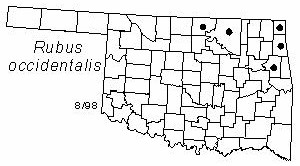Arching, upright shrub. Stems rooting at the tips. Twigs red-purple, glaucous; eglandular, sparsely bristly; prickles stout and broadened at the base, straight or hooked. Leaves alternate, palmately compound, 3-5 foliate; leaflets ovate to ovate-lanceolate, 5-19 cm (2-7.5 in) long and 3.8-8.9 cm (1.5-3.5 in) wide; glabrous above, densely white tomentose beneath; rounded or subcordate at base; margins doubly serrate with occasional shallow lobes; petiole and rachis with many stout prickles. Inflorescence an umbel of 3-7 flowers, pedicels with stout prickles; sepals lanceolate, tomentose, 6-8 mm long; petals 5, white, less than half the length of the sepals; pistils many, inserted on hypanthium; stamens numerous; flowers appear from April to June. Fruit an aggregation of drupelets, 12-15 mm (0.5-0.6 in) in diameter, hemispherical, black, glaucous; fruits mature in June.
Distribution: Oklahoma, Arkansas, Kansas, east to Georgia north to Quebec, west to North Dakota. Common.
Habitat: thickets, roadsides, open woodlands.
Comments: Rubus is a Roman name meaning red; occidentalis refers to western hemisphere distribution.
Field identification: the sepals of black raspberry exceed the petals in length. The prickles are sharp, recurved and stout. Rubus is a complex genus. Species are difficult to identify due to frequent hybridization and introgression.
Medicinal uses: The Kiowa and Apache made a tea from the roots of Rubus species to treat stomach ache. Blackberry root tea was also part of the traditional pharmacopea for treatment of hemorrhaging and hemophilia. In the south, blackberry tea was mixed with whiskey to expel gas. The juice of raspberry fruits was used to flavor medicines.
Food use: fruits are eaten raw or made into jams and jellies.
Wildlife benefits: black raspberry fruits are eaten by many species of birds and mammals. Its dense growth provides excellent cover.
NWI status: none
Distribution in Oklahoma: 
BACK
NEXT
RETURN TO INDEX
Last update: 9/17/99
 Go to Oklahoma Biological Survey Home Page
Go to Oklahoma Biological Survey Home Page
 Disclaimer
Disclaimer